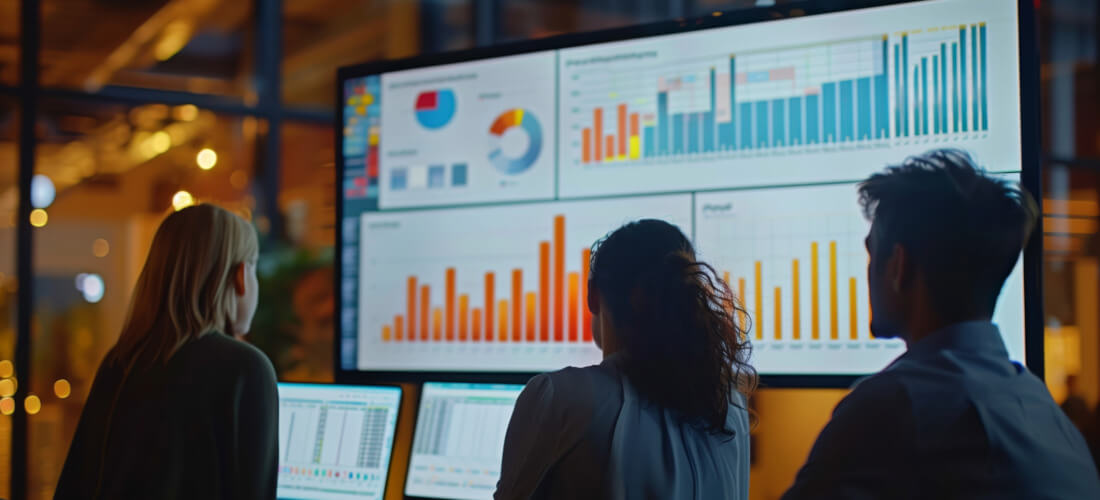
Dealing with bureaucracy, preservation of records, and accessibility issues have been a problem for public service delivery for many years. Today, however, there’s a clear path forward: eliminating paper and going digital. This step not only addresses resident concerns, but also brings a slew of benefits, such as cost savings, efficiency gains, and environmental sustainability.
Here are five essential steps toward achieving an exemplary government and how modern digital solutions can facilitate this journey.
1. Assessing Current Paper-Based Processes
As is standard, the first step before embarking on any transformation initiative is to take stock of existing solutions. Agencies can set up a discovery team that will conduct a thorough analysis of current paper-based processes on various metrics inducing:
- Efficiency: This involves measuring how much an agency’s vital resources like time and personnel it takes to complete paper-based processes. Subtasks such as data entry, document handling, and approval processes are analyzed to identify bottlenecks or redundancies hindering productivity. Getting input from agency staff can be helpful in gauging efficiency.
- Cycle time: This is a measure of how long a government process takes from start to finish. For example, a business license application may involve steps such as review, approval, and issuance and could have a turnaround time of 30 days. Using public data, agencies can measure whether their cycle times are poor, average, or above average.
- Turnaround time: This is the time it takes to fulfill a request. This is a critical contributor to resident satisfaction with government services. For instance, an individual may submit a request to get a copy of their birth certificate. Using paper, completing these tasks may take hours or days but by using digital means, the tasks could be fulfilled in minutes. Paper-based processes risk exposing sensitive information like dates of birth and addresses, whereas digital processes can store data more securely.
- Error rate: This metric assesses the frequency of mistakes or inaccuracies within paper-based government processes. Manual handling of documents and data entry increases the likelihood of human error like typos, misfiling, or lost documents, impacting efficiency and potentially leading to data security or compliance issues in addition to dissatisfaction among residents.
- Throughput: This measures the volume of work completed within a specified period. Given the number of individuals government agencies serve and the expectation of quick service, high throughput is essential for agency staff to manage the influx of information efficiently.
- Effectiveness: At its core, the gauge of government services lies in their ability to effectively tackle resident problems and fulfill their needs. This analysis often involves seeking feedback. Yet, it’s important to also consider how well these services meet additional goals, like regulatory requirements and organizational objectives.
- Cost: Cost analysis involves examining expenses associated with paper-based governmental processes, including materials, labor, equipment, and overhead. This encompasses costs like paper, printing, storage, postage, and manual labor for tasks such as data entry and document handling. Indirect costs like space utilization and maintenance of physical filing systems should also be considered.
By conducting a thorough analysis of existing processes, agencies can uncover potential issues, enabling them to develop a more comprehensive digital solution tailored to address these challenges effectively.
2. Setting Clear Objectives & Goals
Setting clear objectives and goals is crucial for a successful transition to a paperless government. By envisioning the end goal, organizations can better understand how digital systems can address current challenges, streamline processes, and unlock new opportunities.
Breaking down this vision into specific objectives and goals for each department within a government agency, alongside proposed digital strategies, can prove instrumental in achieving desired outcomes.
| Department | Goals | Strategies |
| Finance | Streamline revenue management and financial reporting processes to enhance transparency and accountability in financial transactions. | Utilize digital solutions such as automated tax collection software and real-time reporting tools to improve accuracy, efficiency, and regulatory compliance. |
| Human Resources | Enhance employee engagement and development by improving recruitment and onboarding processes. | Implement digital platforms for talent acquisition, online training modules, and employee feedback systems to facilitate seamless onboarding and foster a culture of continuous learning. |
| Administrative Services | Optimize procurement and supply chain management for increased efficiency in administrative tasks. | Digitize workflows and implement e-procurement systems to achieve cost savings, faster procurement cycles, and better supplier management. |
| Information Technology | Improve IT resource management, strengthen cybersecurity measures, and ensure the reliability of IT infrastructure and systems. | Invest in advanced monitoring tools, conduct regular security audits, and implement robust disaster recovery plans to mitigate risks and ensure business continuity. |
| Clerks & Other Public Service Offices | Enhance constituent engagement and satisfaction through digital platforms for service delivery and communication. | Develop mobile applications for accessing government services, establish online feedback mechanisms, and implement data-driven approaches to improve service delivery efficiency. |
| Legal | Ensure compliance with regulations and streamline legal document management processes. | Digitize legal paperless workflows, implement document automation tools, and enhance collaboration platforms to reduce non-compliance risk and improve overall efficiency. |
3. Implementing Digital Document Management Solutions
Government operations rely heavily on public records and documents. Managing public records like land and vital records effectively ensures consistent service delivery and credibility, enhancing constituent satisfaction and trust. To accomplish this, integrating digital solutions into every aspect of document management is essential.
Digitizing the Stages of Document Management
When managing government documents digitally, there are several key stages to consider.
The first is at the point of origin of a document. This can involve receiving documents from residents or the government generating them upon request. Receipt of documents can be facilitated through an online portal, allowing users to upload documents remotely.
Optical Character Recognition (OCR) technology, which pulls data from an image—whether the image was scanned or received electronically—and electronic signatures on online forms expedite approval processes. This shift to a paperless process speeds up access to vital records like birth and marriage certificates, with automated validation checks ensuring the accuracy and completeness of provided information.
Moving on to document storage and retrieval, organizations can implement automatic indexing systems to organize documents based on keywords, categories, or metadata. This enables quick and easy record retrieval through simple searches and filters, benefiting users and staff.
Enhanced data security measures include authentication for user access and encryption for sensitive information. Blockchain technology can provide a secure and tamper-proof way to manage documents and data while cloud-based document management systems address issues like limited storage capacity and accessibility across various devices and locations.
Finally, in document processing, digital systems offer various features to enhance efficiency. Natural Language Processing (NLP) enables the analysis of documents such as sentiment analysis and summarization of large volumes of text. Big data analytics aids in uncovering insights and supporting decision-making with pattern detection and predictions.
Machine learning and AI algorithms automate tasks like document classification and decision-making processes. Additionally, data extraction and parsing tools automatically extract relevant data from documents, inputting them into databases or other digital systems. For example, in land records processing, these tools efficiently extract information like property boundaries and ownership details from deeds and surveys, facilitating accurate land management and urban development planning.
4. Ensuring Compliance & Security
Cybersecurity threats and data privacy concerns are increasing, making security and compliance top priorities for government agencies. To ensure compliance, agencies should first identify the types of data and transactions involved in government operations, such as citizen personal information, financial records, or healthcare data.
Then, they should research the standards and regulations governing the handling of that data and design digital systems accordingly. For example, PCI DSS compliance can be addressed by incorporating features like firewalls, antivirus integration, and data encryption into paperless government systems.

To promote data privacy compliance while maximizing the value of data, agencies can employ privacy-preserving technologies like homomorphic encryption, differential privacy, and secure multi-party computation. These technologies protect citizens’ privacy while facilitating data analysis for policymaking and governance.
Regarding security, agencies should start by assessing risks associated with digitization to identify potential vulnerabilities, which could include data breaches, sabotage, or malware. By analyzing these risks, governments can understand their potential impact on operations, reputation, and legal standing.
With potential security risks in mind, governmental agencies of all kinds can develop and implement a comprehensive security policy covering the secure handling, storage, and transmission of data. This policy may include measures such as:
- Access control: Implement restricted role-based access and authentication mechanisms like passwords, multi-factor authentication, and biometrics.
- Encryption: Encrypt sensitive information to prevent unauthorized access, especially when transmitting data across public networks. Virtual private networks (VPNs) can also be used for secure remote access.
- Data sovereignty: Define policies that ensure sensitive data is stored and processed within the jurisdiction’s boundaries to maintain control over its security and privacy. This is essential when transitioning to a paperless government system.
- Redundancy and failover: Implement redundant systems and failover mechanisms to ensure continuity of government operations and services in the event of system failures or cyberattacks.
- Supply chain security: Assess and mitigate risks associated with the government’s supply chain, ensuring that hardware, software, and services procured meet stringent security standards and do not introduce vulnerabilities.
- Continuous monitoring and threat intelligence: Regularly audit systems and monitor network activity through a security information and event management (SIEM) system.
- Incident response and remediation: Establish procedures for containing security incidents, conducting forensic analysis, and notifying affected parties as required by law.
- Employee training and awareness: Provide comprehensive training and awareness programs to educate employees about security best practices and their role in safeguarding sensitive information. This includes training on phishing awareness, password hygiene, and proper handling of digital documents.
5. Monitoring Progress & Continuously Improving
Going paperless within any governmental body is a gradual process. It begins with laying a solid digital groundwork for government operations, which can evolve and grow over time.

The first step to continuous improvement is to set clear KPIs for the digital system. These could include metrics like process efficiency, cost savings, customer satisfaction, and compliance. Once these KPIs are defined, they can be assigned baseline values that were noted during initial assessments of paper-based processes.
Next, implement monitoring tools and systems to gather data and track system performance against these established KPIs. Some digital government systems come with reporting tools and dashboards, offering insights into essential operational metrics such as the number of citizens served or public records created. By comparing these metrics with their paper-based counterparts, it becomes clear whether KPIs are being met.
The collected performance data is then analyzed to uncover trends, patterns, and areas for improvement. Look for correlations between different metrics and assess the impact of any changes or interventions on overall performance. Additionally, gather feedback through staff interviews and citizen reviews to understand user experiences and pain points such as usability and accessibility issues. Prioritize changes based on their significance, addressing critical issues before tackling lesser ones like aesthetics.
Once enhancements have been designed to address identified issues, it is advisable to implement these changes iteratively. Transitioning to a paperless workflow within government takes time and does not need to be done all at once. This may involve testing the changes with small-scale pilot projects before making them live. Alternatively, establishing test groups for beta testing can increase the likelihood of a successful full-scale implementation.
Throughout this journey, nurturing a culture of continuous improvement within the organization can be invaluable.
Your Perfect Partner for a Paperless Future
Transitioning government operations to a paperless system brings a host of benefits, from increased efficiency to a lighter environmental footprint. Yet, this journey isn’t devoid of challenges. However, with the right partner, you can navigate the digitization process smoothly and cost-effectively.
GovOS, through best-in-class software, empowers state and local governments in their transition towards paperless processes. With our secure true cloud platform, you gain end-to-end digital control over compliance management and revenue transactions, eliminating the need for cumbersome paperwork and fostering greater satisfaction among your constituents.
Ready to shred the paper? Explore GovOS products for government agencies or talk to an expert to discover firsthand how GovOS can deliver solutions to lead your agency to digital governance success.









